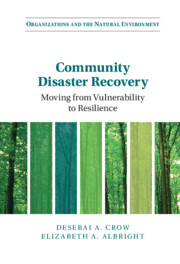Book contents
- Community Disaster Recovery
- Organizations and the Natural Environment
- Community Disaster Recovery
- Copyright page
- Dedication
- Contents
- Figures
- Tables
- About the Authors
- Foreword
- Preface
- Acknowledgments
- Abbreviations
- Part I Introduction
- Part II Damage and Resources
- Part II Review
- Part III Individual Beliefs
- 5 Worldviews, Risk Perceptions, and Causal Beliefs
- 6 Trust in Government and Support for Policy Action
- Part III Review
- Part IV Individual and Group Engagement
- Part IV Review
- Part V Connections, Conclusions, and Recommendations
- Book part
- Bibliography
- Index
5 - Worldviews, Risk Perceptions, and Causal Beliefs
How Individuals Experience Disasters
from Part III - Individual Beliefs
Published online by Cambridge University Press: 08 October 2021
- Community Disaster Recovery
- Organizations and the Natural Environment
- Community Disaster Recovery
- Copyright page
- Dedication
- Contents
- Figures
- Tables
- About the Authors
- Foreword
- Preface
- Acknowledgments
- Abbreviations
- Part I Introduction
- Part II Damage and Resources
- Part II Review
- Part III Individual Beliefs
- 5 Worldviews, Risk Perceptions, and Causal Beliefs
- 6 Trust in Government and Support for Policy Action
- Part III Review
- Part IV Individual and Group Engagement
- Part IV Review
- Part V Connections, Conclusions, and Recommendations
- Book part
- Bibliography
- Index
Summary
Communities across the globediffer in history, culture, and beliefs; and these differences may help drive how communities process, learn from, and recover after a disaster. When faced with natural disasters, communities respond in diverse ways, with processes that reflect their cultures, needs, the type and extent of damage incurred and resources available to the community. Chapter 5 of Community Disaster Recovery: Moving from Vulnerability to Resilience articulates the ways in which internal community characteristics influence the disaster recovery processes and decisions made by local governments. Prior disaster experience and damage from the most recent disaster, along with perceptions of problem severity and future risk perceptions can influence the degree to which residents view disasters as an increasing and urgent problem for their local governments to manage. Finally, local government information dissemination during disaster recovery can serve two important roles: (1) garnering support for local government action and trust in government decisions, along with (2) incorporating a range of views beyond only technocratic experts to build innovative policy solutions.
Keywords
- Type
- Chapter
- Information
- Community Disaster RecoveryMoving from Vulnerability to Resilience, pp. 87 - 99Publisher: Cambridge University PressPrint publication year: 2021

